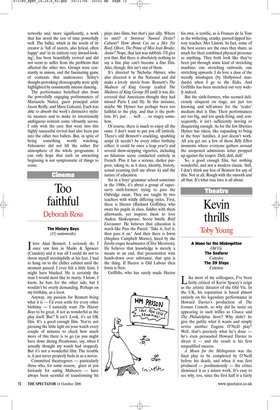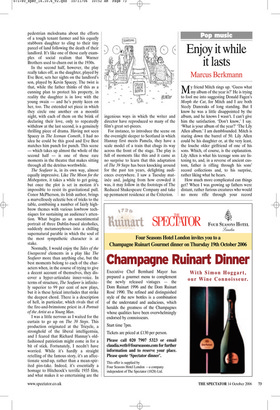Kevin thrills
Toby Young
A Moon for the Misbegotten
Old Vic
The Seafarer Cottesloe The 39 Steps Criterion Like most of my colleagues, I’ve been fairly critical of Kevin Spacey’s reign as the artistic director of the Old Vic. In the UK, his reputation is based almost entirely on his legendary performance in Howard Davies’s production of The Iceman Cometh, so why did he insist on appearing in such trifles as Cloaca and The Philadelphia Story? Why didn’t he give the public what it wants and simply revive another Eugene O’Neill play? Well, that’s precisely what he’s done — he’s even persuaded Howard Davies to direct it — and the result is his first unqualified success.
A Moon for the Misbegotten was the final play to be completed by O’Neill before his death, and when it was first produced — posthumously — the critics dismissed it as a minor work. It’s easy to see why, too, since the first half is a fairly pedestrian melodrama about the efforts of a tough tenant farmer and his equally stubborn daughter to cling to their tiny parcel of land following the death of their landlord. It’s like one of those early examples of social realism that Warner Brothers used to churn out in the 1930s.
In the second half, however, the play really takes off, as the daughter, played by Eve Best, sets her sights on the landlord’s son, played by Kevin Spacey. The twist is that, while the father thinks of this as a cunning plan to protect his property, in reality the daughter is in love with the young swain — and he’s pretty keen on her, too. The extended set piece in which they circle one another on a moonlit night, with each of them on the brink of declaring their love, only to repeatedly withdraw at the last second, is a genuinely thrilling piece of drama. Having not seen Spacey in The Iceman Cometh, I had no idea he could be this good and Eve Best matches him punch for punch. This scene — which takes up almost the whole of the second half — is one of those rare moments in the theatre that makes sitting through all the detritus worthwhile.
The Seafarer is, in its own way, almost equally impressive. Like The Moon for the Misbegotten, it takes a while to get going, but once the plot is set in motion it’s impossible to resist its gravitational pull. Conor McPherson, its Irish author, brings a marvellously eclectic box of tricks to the table, combining a number of fairly highbrow themes with various lowbrow techniques for sustaining an audience’s attention. What begins as an unsentimental portrait of three Dublin-based alcoholics, suddenly metamorphoses into a chilling supernatural parable in which the soul of the most sympathetic character is at stake.
Normally, I would enjoy the Tales of the Unexpected elements in a play like The Seafarer more than anything else, but the best moments belong to each of the characters when, in the course of trying to give a decent account of themselves, they discover a hyper-articulate inner-voice. In terms of structure, The Seafarer is infinitely superior to 99 per cent of new plays, but it is these lyrical interludes that strike the deepest chord. There is a description of hell, in particular, which rivals that of the fire-and-brimstone priest in A Portrait of the Artist as a Young Man.
I was a little nervous as I waited for the curtain to go up on The 39 Steps. This production originated at the Tricycle, a stronghold of the liberal intelligentsia, and I feared that Richard Hannay’s oldfashioned patriotism might come in for a bit of stick. Fortunately, I needn’t have worried. While it’s hardly a straight retelling of the famous story, it’s an affectionate send-up, rather than a mean-spirited piss-take. Indeed, it’s essentially a homage to Hitchcock’s terrific 1935 film, and what makes it so entertaining are the ingenious ways in which the writer and director have reproduced so many of the film’s great set-pieces.
For instance, to introduce the scene on the overnight sleeper to Scotland in which Hannay first meets Pamela, they have a scale model of a train that chugs its way across the front of the stage. The play is full of moments like this and it came as no surprise to learn that this adaptation of The 39 Steps has been knocking around for the past ten years, delighting audiences everywhere. I saw a Tuesday matinée and, judging from how crowded it was, it may follow in the footsteps of The Reduced Shakespeare Company and take up permanent residence at the Criterion.



































































































 Previous page
Previous page